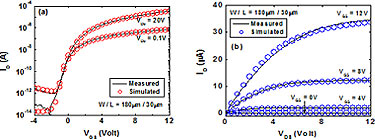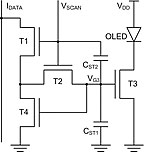
a-InGaZnO TFT Pixel Circuits For AM-OLED
Charlene Chen and Jerzy Kanicki

Amorphous In-Ga-Zn-O thin film transistors (TFTs) possess several advantages including visible transparency, good uniformity, low processing temperature, decent field-effect mobility, low off-current and sharp subthreshold swing, which make them very favorable for future flat panel displays (FPDs). In this project, we investigated the possible application of the a-InGaZnO TFT pixel circuits to active-matrix organic light-emitting display (AM-OLED).
First, the a-InGaZnO TFT SPICE model was developed based on the Rensselaer Polytechnic Institute (RPI) a-Si:H TFT model. All a-InGaZnO TFT SPICE parameters were extracted from experimental data. HSPICE simulation tool was then used to simulate the a-IGZO TFT characteristics. We can see from the figures below that the RPI a-Si:H TFT model with appropriate a-InGaZnO TFT SPICE parameters can reproduce very well measured device characteristics.
| |
 |
| |
Schematic diagram of the 4-TFT current-scaling current mirror pixel. |
We then simulated several for pixel circuits AM-OLED based on the developed a-InGaZnO TFT model. We found that smaller device sizes and lower supply voltages could be used in a-InGaZnO TFT pixel circuits due to their superior electrical properties as compared to those of a-Si:H TFTs. Therefore, higher resolution and lower power consumption AM-OLEDs can be achieved.
The impact of the TFT threshold voltage instability (ΔVT) on pixel circuit performance was also investigated. We discovered that due to the much lower designed gate overdrive voltage (VGS – VT) in a-InGaZnO TFT pixel circuits, the constraint of ΔVT is higher as compared to that of a-Si:H TFTs. In other words, very stable a-InGaZnO TFTs (ΔVT) are required to realize AM-OLED pixel circuits. We therefore believe that further improvements of the electrical stability of a-InGaZnO TFTs are needed before their application to AM-OLEDs. This research is supported by Canon Corporation.
C. Chen, K. Abe, H. Kumoni, T.-C. Fung, and J. Kanicki, AM-FPD ’08, pp. 251-252, 2008.
top
|

